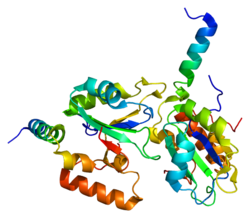| SF3B6 |
|---|
 |
|
| Identifiers |
|---|
| Aliases | SF3B6 , HSPC175, Ht006, P14, SAP14, SAP14a, SF3B14, SF3B14a, CGI-110, splicing factor 3b subunit 6 |
|---|
| External IDs | OMIM: 607835; MGI: 1913305; HomoloGene: 9360; GeneCards: SF3B6; OMA:SF3B6 - orthologs |
|---|
|
|
| RNA expression pattern |
|---|
| Bgee | | Human | Mouse (ortholog) |
|---|
| Top expressed in | - skin of arm
- mucosa of ileum
- olfactory zone of nasal mucosa
- Achilles tendon
- mucosa of sigmoid colon
- ganglionic eminence
- cartilage tissue
- islet of Langerhans
- rectum
- tibialis anterior muscle
|
| | Top expressed in | - saccule
- otic placode
- otic vesicle
- medial ganglionic eminence
- transitional epithelium of urinary bladder
- migratory enteric neural crest cell
- abdominal wall
- cervix
- endocardial cushion
- ventricular zone
|
| | More reference expression data |
|
|---|
| BioGPS | |
|---|
|
|
|
| Wikidata |
|







